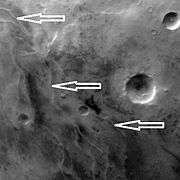Dorsa Argentea Formation
The Dorsa Argentea Formation (DAF) is thought to be a large system of eskers that were under an ancient ice cap in the south polar region of Mars. This group of ridges extends from 270–100 E and 70–90 S, around the south pole of Mars. It sits under the Late Amazonian South Polar Layered Deposits (SPLD), in the Mare Australe quadrangle. The amount of these ridges is huge, one study studied seven different ridge systems which contained almost 4,000 ridges that had a total length 51,000 km.[1]
Most eskers are thought to be formed inside ice-walled tunnels by streams which flowed within and under glaciers. After the retaining ice walls melted away, stream deposits remained as long winding ridges.
Crater counts show that the ridges are of two different ages. One dates from Early Hesperian, while the other group dates to the Late Noachian. These dates correspond to the time when Mars had lakes and valley networks which formed from runoff, drainage and storage of liquid water on the surface of Mars.[2]
The Dorsa Argentea Formation represents a time when there was melting and drainage of meltwater from a giant ice sheet around the Martian South Pole. Various mechanisms may have caused the ice to melt. Possible mechanisms may have been a warmer atmosphere, volcanism, or increased thickness of the ice cap from accumulating snow.[3][4][5][6][7][8][9]
MARSIS radar data suggest that significant areas of layered, potentially ice-rich parts of the Dorsa Argentea Formation remain today.[10][11][12]
-

Ridges, believed to be eskers of the Dorsa Argentea Formation, as seen by Mars Global Surveyor wide angle MOC. White arrows point to the ridges.
References
- ↑ Kress, A.; Head, J. (2015). "Late Noachian and early Hesperian ridge systems in the south circumpolar Dorsa Argentea Formation, Mars: Evidence for two stages of melting of an extensive late Noachian ice sheet". Planetary and Space Science. 109-110: 1–20. Bibcode:2015P&SS..109....1K. doi:10.1016/j.pss.2014.11.025.
- ↑ Kress, A., J. Head. 2015. Late Noachian and early Hesperian ridge systems in the south circumpolar Dorsa Argentea Formation, Mars: Evidence for two stages of melting of an extensive late Noachian ice sheet. Planetary and Space Science: 109-110, 1-20
- ↑ Fastook, J.; Head, J.; Marchant, D.; Forget, F.; Madeleine, J. (2012). "Early Mars climate near the Noachian-Hesperian boundary: independent evidence for cold conditions from basal melting of the south polar ice sheet (Dorsa Argentea Formation) and implications for valley network formation". Icarus. 219: 25–40. doi:10.1016/J.Icarus.2012.02.013.
- ↑ Ghatan, G.; Head, J. (2002). "Candidate subglacial volcanoes in the south polar region of Mars: morphology, morphometry, and eruption conditions". J. Geophys. Res. 107: 5048. doi:10.1029/2001JE001519.
- ↑ Ghatan, G.; Head, J. (2004). "Regional drainage of meltwater beneath a Hesperian aged south circumpolar ice sheet on Mars". J. Geophys. Res. 109: E07006. Bibcode:2004JGRE..109.7006G. doi:10.1029/2003JE002196.
- ↑ Ghatan, G.; Head, J.; Pratt, S. (2003). "Cavi Angusti, Mars: characterization and assessment of possible formation mechanisms". J. Geophys. Res. 108: 5045. Bibcode:2003JGRE..108.5045G. doi:10.1029/2002JE001972.
- ↑ Head, J.; Pratt, S. (2001). "Extensive hesperian-aged south polar ice sheet on Mars: evidence for massive melting and retreat, and lateral flow and ponding of meltwater". J. Geophys. Res. 106: 12275–12300. Bibcode:2001JGR...10612275H. doi:10.1029/2000je001359.
- ↑ Fastook, J.; Head, J.; Marchant, D.; Forget, F.; Madeleine, J. (2012). "Early Mars climate near the Noachian-Hesperian boundary: independent evidence for cold conditions from basal melting of the south polar ice sheet (Dorsa Argentea Formation) and implications for valley network formation". Icarus. 219: 25–40. doi:10.1016/J.Icarus.2012.02.013.
- ↑ Wordsworth, R.; Forget, F.; Millour, E.; Head, J.; Madeleine, J.; Charnay, B. (2013). "Global modeling of the early martian climate under a denser CO2 atmosphere: water cycle and ice evolution". Icarus. 222: 1–19. doi:10.1016/J.Icarus.2012.09.036.
- ↑ Plaut, J., Ivanov, A., Safaeinili, A., Milkovich, S., Picardi, G., Seu, R., Phillips, R. 2007a. Radar sounding of subsurface layers in the South Polar plains of Mars: correlation with the Dorsa Argentea formation. Lunar Planet. Sci. XXXVIII (abstract 2144).
- ↑ Head, J., Marchant, D. 2006. Regional polar glaciation in the hesperian periodof the history of Mars. The South Circumpolar Dorsa Argentea Formation as an Ancient Ice Sheet Remnant. Fourth Mars Polar Science Conference. Davos,Switzerland.
- ↑ Head, J., Marchant, D., Forget, F. 2007. Regional polar glaciation in the hesperian period of the history of Mars: the south circumpolar Dorsa Argentea formation as an ancient ice sheet remnant. Seventh International Conference on Mars. Pasadena, CA (abstract 3115).
See also
- Climate of Mars
- Esker
- Glaciers
- Glaciers on Mars
- Mare Australe quadrangle
- Mars Global Surveyor
- Mars Orbiter Camera
- Martian polar ice caps